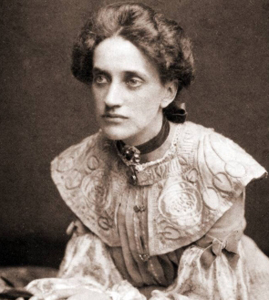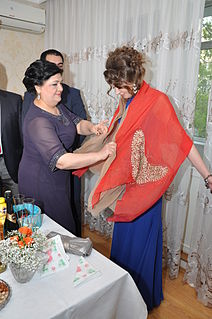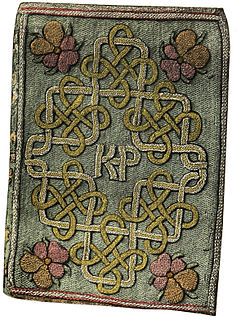Related Research Articles

Embroidery is the craft of decorating fabric or other materials using a needle to apply thread or yarn. Embroidery may also incorporate other materials such as pearls, beads, quills, and sequins. In modern days, embroidery is usually seen on caps, hats, coats, blankets, dress shirts, denim, dresses, stockings, and golf shirts. Embroidery is available with a wide variety of thread or yarn color.

A needlework sampler is a piece of embroidery or cross-stitching produced as a 'specimen of achievement', demonstration or a test of skill in needlework. It often includes the alphabet, figures, motifs, decorative borders and sometimes the name of the person who embroidered it and the date. The word sampler is derived from the Latin exemplum, which means 'example'.

Assisi embroidery is a form of counted-thread embroidery based on an ancient Italian needlework tradition in which the background is filled with embroidery stitches and the main motifs are outlined but not stitched. The name is derived from the Italian town of Assisi where the modern form of the craft originated.

Hardanger embroidery or "Hardangersøm" is a form of embroidery traditionally worked with white thread on white even-weave linen or cloth, using counted thread and drawn thread work techniques. It is sometimes called whitework embroidery.

Lace is a delicate fabric made of yarn or thread in an open weblike pattern, made by machine or by hand.

Ann Macbeth was a British embroiderer, designer, teacher and author, a member of the Glasgow Movement and an associate of Charles Rennie Mackintosh {{Citation needed}}. She was also an active suffragette and designed banners for suffragists and suffragettes movements.

Crewel embroidery, or crewelwork, is a type of surface embroidery using wool. A wide variety of different embroidery stitches are used to follow a design outline applied to the fabric. The technique is at least a thousand years old.

A shawl is a simple item of clothing, loosely worn over the shoulders, upper body and arms, and sometimes also over the head. It is usually a rectangular or square piece of cloth, which is often folded to make a triangle, but can also be triangular in shape. Other shapes include oblong shawls.

Backstitch or back stitch and its variants stem stitch, outline stitch and split stitch are a class of embroidery and sewing stitches in which individual stitches are made backward to the general direction of sewing. In embroidery, these stitches form lines and are most often used to outline shapes and to add fine detail to an embroidered picture. It is also used to embroider lettering. In hand sewing, it is a utility stitch which strongly and permanently attaches two pieces of fabric. The small stitches done back-and-forth makes the back stitch the strongest stitch among the basic stitches. Hence it can be used to sew strong seams by hand, without a sewing machine.

Broderie anglaise is a whitework needlework technique incorporating features of embroidery, cutwork and needle lace that became associated with England, due to its popularity there in the 19th century.

Candlewicking, or Candlewick is a form of whitework embroidery that traditionally uses an unbleached cotton thread on a piece of unbleached muslin. It gets its name from the nature of the soft spun cotton thread, which was braided then used to form the wick for candles. Motifs are created using a variety of traditional embroidery stitches as well as a tufted stitch. Subject matter is usually taken from nature - flowers, insects, pine trees, and so on, Other traditional motifs resemble Pennsylvania Dutch or Colonial American designs. Modern designs include colored floss embroidery with the traditional white on white stitching.

Chikan is a traditional embroidery style from Lucknow, India. Literally translated, the word means embroidery, and it is one of Lucknow's best known textile decoration styles. The market for local chikan is mainly in Chowk, Lucknow.

Buttonhole stitch and the related blanket stitch are hand-sewing stitches used in tailoring, embroidery, and needle lace-making.
Mountmellick embroidery or Mountmellick work is a floral whitework embroidery originating in the town of Mountmellick in County Laois, Ireland, in the early nineteenth century.

In embroidery, plainweave is a technical category of woven base fabrics that are suitable for working certain varieties of embroidery. Plainweave fabrics have a tight weave and individual threads are not readily visible. Surface embroidery may be performed on plainweave, such as crewel work, goldwork, stumpwork, cutwork, and candlewicking.

English embroidery includes embroidery worked in England or by English people abroad from Anglo-Saxon times to the present day. The oldest surviving English embroideries include items from the early 10th century preserved in Durham Cathedral and the 11th century Bayeux Tapestry, if it was worked in England. The professional workshops of Medieval England created rich embroidery in metal thread and silk for ecclesiastical and secular uses. This style was called Opus Anglicanum or "English work", and was famous throughout Europe.

Embroidery was an important art in the Islamic world from the beginning of Islam until the Industrial Revolution disrupted traditional ways of life.
Mrs Jamieson, the wife of an Ayr cotton agent, was an enterprising philanthropist who introduced sewed muslin to Ayrshire ca. 1814. Perhaps inspired by Italian Luigi Ruffini, who in 1782 had set up an embroidery school in Edinburgh, she undertook to teach local women the necessary embroidery techniques, allowing them to work as outworkers at the trade. The finished product was widely marketed and exported, especially to North America. Her scheme had so much success that it was later exported to Madeira as relief work.

Hedebo embroidery covers several forms of white embroidery which originated in the Hedebo (heathland) region of Zealand, Denmark, in the 1760s. The varied techniques which evolved over the next hundred years in the farming community were subsequently developed by the middle classes until around 1820. They were applied to articles of clothing such as collars and cuffs but were also used to decorate bed linen.
Margaret Helen Swain was an English embroidery and textile historian. Trained as a nurse in London, she began a career as a historian after noticing no history about Ayrshire whitework embroidery in books following an exhibition at the Signet Library which she visited. Swain's research on the subject resulted in the publication of several books, she held two exhibitions, and wrote about embroidery, household textiles and tapestries in museum journals, magazines and newspapers. She was awarded an honourary Master of Arts degree from the University of Edinburgh in 1981. A pencil portrait of Swain was made by Elizabeth Blackadder and a collection of papers and objects related to her career are stored at National Museums Scotland.
References
- ↑ Margaret Swain, Ayrshire and Other Whitework (Shire Publications, 2001), p. 15.
- ↑ Anthony Cooke, The Rise and Fall of the Scottish Cotton Industry, 1778-1914 (Manchester University Press, 2010), p. 42-3.
- ↑ Margaret Swain, Scottish Embroidery: Medieval to Modern (BT Batsford, 1986), p. 97.
- ↑ Heather Toomer, Embroidered With White (Heather Toomer Antique Lace, 2008), p. 106.
- ↑ Margaret Swain, Scottish Embroidery: Medieval to Modern (BT Batsford, 1986), p. 21.
- ↑ "Ayrshire whitework". Encyclopedia Britannica. Retrieved 28 March 2017.
- ↑ Margaret Swain, Scottish Embroidery: Medieval to Modern (BT Batsford, 1986), p. 21.
| This textile arts article is a stub. You can help Wikipedia by expanding it. |


